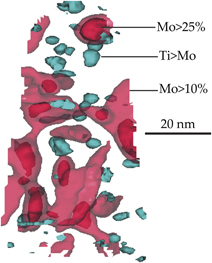Crossref Citations
This article has been cited by the following publications. This list is generated based on data provided by
Crossref.
Shmulevitsh, M.
Meshi, L.
Pinkas, M.
and
Shneck, R. Z.
2015.
Elastic consideration of the precipitation in model alloys of maraging steels: theory and experimental validation.
Journal of Materials Science,
Vol. 50,
Issue. 14,
p.
4970.
Du, Wei
Bai, Qian
and
Zhang, Bi
2016.
A Novel Method for Additive/Subtractive Hybrid Manufacturing of Metallic Parts.
Procedia Manufacturing,
Vol. 5,
Issue. ,
p.
1018.
Lewandowski, John J.
and
Seifi, Mohsen
2016.
Metal Additive Manufacturing: A Review of Mechanical Properties.
Annual Review of Materials Research,
Vol. 46,
Issue. 1,
p.
151.
Jägle, Eric A.
Sheng, Zhendong
Wu, Liang
Lu, Lin
Risse, Jeroen
Weisheit, Andreas
and
Raabe, Dierk
2016.
Precipitation Reactions in Age-Hardenable Alloys During Laser Additive Manufacturing.
JOM,
Vol. 68,
Issue. 3,
p.
943.
Colombo, Paolo
Demir, Ali Gökhan
and
Previtali, Barbara
2016.
Selective laser melting of 18NI300 maraging stell: Effect of PW emission in part quality.
p.
P181.
Chen, Hongyu
and
Gu, Dongdong
2016.
Effect of metallurgical defect and phase transition on geometric accuracy and wear resistance of iron-based parts fabricated by selective laser melting.
Journal of Materials Research,
Vol. 31,
Issue. 10,
p.
1477.
Casati, Riccardo
Lemke, Jannis
Tuissi, Ausonio
and
Vedani, Maurizio
2016.
Aging Behaviour and Mechanical Performance of 18-Ni 300 Steel Processed by Selective Laser Melting.
Metals,
Vol. 6,
Issue. 9,
p.
218.
Herzog, Dirk
Seyda, Vanessa
Wycisk, Eric
and
Emmelmann, Claus
2016.
Additive manufacturing of metals.
Acta Materialia,
Vol. 117,
Issue. ,
p.
371.
Jägle, Eric
Sheng, Zhendong
Kürnsteiner, Philipp
Ocylok, Sörn
Weisheit, Andreas
and
Raabe, Dierk
2016.
Comparison of Maraging Steel Micro- and Nanostructure Produced Conventionally and by Laser Additive Manufacturing.
Materials,
Vol. 10,
Issue. 1,
p.
8.
Kürnsteiner, Philipp
Wilms, Markus B.
Weisheit, Andreas
Barriobero-Vila, Pere
Jägle, Eric A.
and
Raabe, Dierk
2017.
Massive nanoprecipitation in an Fe-19Ni-xAl maraging steel triggered by the intrinsic heat treatment during laser metal deposition.
Acta Materialia,
Vol. 129,
Issue. ,
p.
52.
Suryawanshi, Jyoti
Prashanth, K.G.
and
Ramamurty, U.
2017.
Tensile, fracture, and fatigue crack growth properties of a 3D printed maraging steel through selective laser melting.
Journal of Alloys and Compounds,
Vol. 725,
Issue. ,
p.
355.
Tan, Chaolin
Zhou, Kesong
Ma, Wenyou
Zhang, Panpan
Liu, Min
and
Kuang, Tongchun
2017.
Microstructural evolution, nanoprecipitation behavior and mechanical properties of selective laser melted high-performance grade 300 maraging steel.
Materials & Design,
Vol. 134,
Issue. ,
p.
23.
Takezawa, Akihiro
Koizumi, Yuichiro
and
Kobashi, Makoto
2017.
High-stiffness and strength porous maraging steel via topology optimization and selective laser melting.
Additive Manufacturing,
Vol. 18,
Issue. ,
p.
194.
Bai, Yuchao
Yang, Yongqiang
Wang, Di
and
Zhang, Mingkang
2017.
Influence mechanism of parameters process and mechanical properties evolution mechanism of maraging steel 300 by selective laser melting.
Materials Science and Engineering: A,
Vol. 703,
Issue. ,
p.
116.
Demir, Ali Gökhan
Colombo, Paolo
and
Previtali, Barbara
2017.
From pulsed to continuous wave emission in SLM with contemporary fiber laser sources: effect of temporal and spatial pulse overlap in part quality.
The International Journal of Advanced Manufacturing Technology,
Vol. 91,
Issue. 5-8,
p.
2701.
Gorsse, Stéphane
Hutchinson, Christopher
Gouné, Mohamed
and
Banerjee, Rajarshi
2017.
Additive manufacturing of metals: a brief review of the characteristic microstructures and properties of steels, Ti-6Al-4V and high-entropy alloys.
Science and Technology of Advanced Materials,
Vol. 18,
Issue. 1,
p.
584.
Knoll, Helene
Ocylok, Sörn
Weisheit, Andreas
Springer, Hauke
Jägle, Eric
and
Raabe, Dierk
2017.
Combinatorial Alloy Design by Laser Additive Manufacturing.
steel research international,
Vol. 88,
Issue. 8,
p.
1600416.
Demir, Ali Gökhan
and
Previtali, Barbara
2017.
Investigation of remelting and preheating in SLM of 18Ni300 maraging steel as corrective and preventive measures for porosity reduction.
The International Journal of Advanced Manufacturing Technology,
Vol. 93,
Issue. 5-8,
p.
2697.
Sander, J.
Hufenbach, J.
Bleckmann, M.
Giebeler, L.
Wendrock, H.
Oswald, S.
Gemming, T.
Eckert, J.
and
Kühn, U.
2017.
Selective laser melting of ultra-high-strength TRIP steel: processing, microstructure, and properties.
Journal of Materials Science,
Vol. 52,
Issue. 9,
p.
4944.
Poprawe, Reinhart
Bleck, Wolfgang
Piller, Frank Thomas
Schuh, Günther
Barg, Sebastian
Bohl, Arne
Bremen, Sebastian
Bültmann, Jan
Hinke, Christian
Jiang, Ruth
Kleer, Robin
Merkt, Simon
Prahl, Ulrich
Riesener, Michael
Schrage, Johannes
Weller, Christian
and
Ziegler, Stephan
2017.
Integrative Production Technology.
p.
23.
